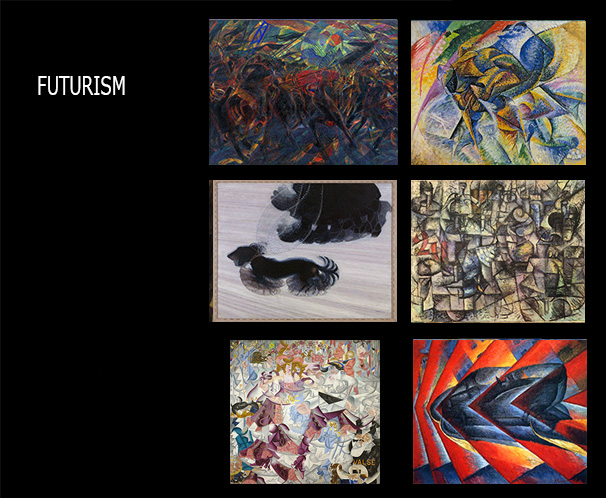
Futurism 00
written by artinthefridge
Futurism
Futurism (ital. futurismo, from futuro: "future") is a literary and artistic movement that in Italy at the beginning of the 20th century rejected the museum past of the 19th century, as well as the psychological sensibility of musically inspired symbolism, in the name of the ideal of warrior masculinity and the violent technological acceleration of a highly industrialized society.
The program was presented in 1909 by the Italian writer F. T. Marinetti in a manifesto that polemicized against barren academic culture, glorified the civilization of machines, promoted dynamism and aggressiveness, and opposed intricate logic and syntax in the name of expressive rawness.
Although futurism left innovative traces in sculpture, architecture, photography, and film, it was primarily a movement of poets and painters, whose activities were closely intertwined. The support of some of its representatives for colonial expansion and fascism earned it a bad reputation and led to indignant rejection. There has been a special type of futuristic painting since 1929 by the second generation of futurists, the so-called "neofuturista," or "aeropittura," but it has been discredited through its political association with fascism.
Five young Italian painters—Umberto Boccioni, Carlo Carrà, Luigi Russolo, Giacomo Balla, and Gino Severini—published in Turin (1910) the Manifesto of the Futurist Painters (Manifesto dei pittori futuristi), in which they stood for Marinetti's ideas and a new vision of the world.
In painting, narratives and third dimensions are renounced; they strive to realize the sensations of the rhythm of modern life with disturbed lines and the mutual interweaving of forms and plans in movement. They reject static, break shapes into prismatic volumes, and apply sharp contrasts of bright colors.
Despite the common program, each of these painters brings their own component to futurism. Boccioni, the main theorist of the movement, was also a sculptor who wanted to express the power of the machine and the dynamism of the form through the decomposition of the human body and object; Carrà brought emotional drama to gray Cubist tonalities; Severini tried to synthesize cubist statics and futuristic dynamism with tonal scales; Balla leaned towards expressive dynamic compositions; and Russolo anticipated the freedom of surrealism with his musical dynamism and poetic intuition.
The principles of futurist architecture were published in 1914 in a visionary manifesto by Antonio Sant'Elia. It starts with basic functionality and uses reinforced concrete, iron, and glass.
Futurism is the only Italian non-conformist art movement from the beginning of the 20th century; it strongly influenced the avant-garde movements of that era (Cubo-Futurism, Rayonism, Suprematism, and Constructivism in Russia, and Vorticism in England).
Lit.:
M. Seuphor, L'Art abstrait, Paris 1950
H. W. Janson, History Of Art,1967
.
ArtintheFridge, September 2022
.
Links to other articles:
Modern Art
https://www.fxhash.xyz/article/modern-art-00
Impressionism
https://www.fxhash.xyz/article/impressionism-00
Post-Impressionism
https://www.fxhash.xyz/article/post-impressionism-00
Fauvism
https://www.fxhash.xyz/article/fauvism
Cubism
https://www.fxhash.xyz/article/cubism-00
Expressionism